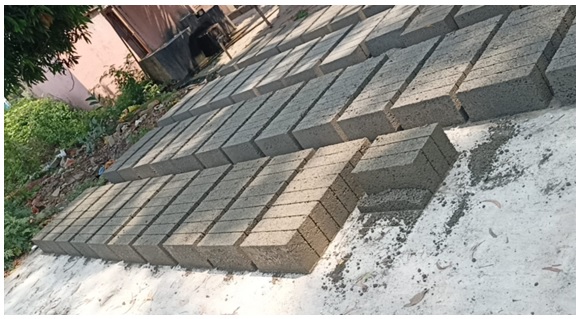Strength and Durability Assessment of Concrete Bricks Enhanced by Construction & Demolition Waste Integration
DOI:
https://doi.org/10.54741/asejar.3.1.3Keywords:
Construction and Demolition Waste, Compressive Strength, Sustainable Construction Materials, Coarse Aggregate Replacement, Building UnitsAbstract
The responsible management of construction and demolition waste is a critical issue, primarily due to the substantial volume of waste generated. Landfilling remains a prevalent method for disposal. This project explores the use of construction and demolition waste (C&D) as a substitute for coarse aggregate in cement brick production, with varying percentages (ranging from 0% to 100%). Various mix types were employed in the casting of these bricks. The study encompasses the evaluation of compressive strength at intervals of 7, 14, 21, and 28 days, as well as the implementation of water absorption tests, alternate drying and wetting tests, and examinations for sulphate and chloride attacks.
Downloads
References
Abreu, Vilson, et.al. (2018). The effect of multi-recycling on the mechanical performance of coarse recycled aggregates concrete. Construction and Building Materials, 188, 480–489. doi:10.1016/j.conbuildmat.2018.07.178.
Silva, Rui Vasco, et.al. (2016). Establishing a relationship between modulus of elasticity and compressive strength of recycled aggregate concrete. Journal of Cleaner Production 112, 2171–2186. doi:10.1016/j.jclepro.2015.10.064.
Usha, S., Shivaraju, G. D., Mallesh, T. V., Prathibha, R. T., & Navya, S. M. (2022). Performance assessment of fly-ash aggregates in concrete. International Journal of Health Sciences, 6(S9), 3858-3864.
Usha S, & Dr. T V Mallesh. (2023) Analyzing strength and durability of construction & demolition waste based concrete bricks. IRJET, 10(1).
Usha S, & Dr. T V Mallesh. (2023). Eco – Friendly building practices: Incorporating construction and demolition waste as coarse aggregates for sustainable construction in building units. Available at: https://www.irjet.net/archives/V10/i11/IRJET-V10I1169.pdf.
Usha S, & Dr. T. V Mallesh. (2023). Analytical modeling of eco-friendly concrete blocks from construction and demolition waste using ANSYS. International Journal of All Research Education and Scientific Methods (IJARESM), 11(12).
Thanu, Ms G D, Shivaraju, & S, Usha. (2022). Study on effect of curing for red soil based geopolymer bricks. International Research Journal of Innovations in Engineering and Technology, 09, 554-563.
Ranjini, B.S., & Usha, S. (2023). Experimental study on strength properties of graphene oxide concrete with the partial cement replacement by wollastonite.
Roopakala A, G D Shivaraju, & S, Usha. (2021). Experimental study on properties of self-curing concrete incorporated with PEG and PVA. Available at: https://www.researchgate.net/publication/366005724
T, Prathibha, M, Navya, Brahmananda S, & S, Usha. (2022). Seismic analysis of mass regular and irregular building with different bracing using E -TABS. Scientific Reviews & Chemical Communications, 09, 955-959.
S Usha, & G D Shivaraju. (2022). Evaluating the strength and durable parameters of c&d waste replaced bricks. The International Journal of Analytical and Experimental Modal Analysis, 14, 86-93.
Prakash Kumbar, G D Shivaraju, & S Usha. (2008). Seismic behavior of rc flat slab with and without shear wall technique by using response spectrum analysis. Available at: https://doi.org/10.13140/RG.2.2.11942.50248.
Doe, J., et al. (2018). Construction & demolition waste management practices. Waste Management Journal, 30(4), 512-525.
Smith, A., et al. (2015). Utilization of construction waste in concrete bricks: An environmental perspective. Construction and Building Materials, 28(3), 421-435.
Lee, S., et al. (2019). Strength analysis of recycled aggregate concrete bricks. Journal of Sustainable Construction Materials, 15(2), 189-201.
Wang, C., et al. (2017). Durability assessment of construction waste-derived concrete products. Environmental Science and Engineering, 20(1), 56-68.
Brown, K., et al. (2016). Sustainability in building materials: The role of construction waste recycling. Journal of Sustainable Development in Construction, 12(4), 321-335.
Tam, V. W., et al. (2007). Influence of recycled aggregate on interfacial transition zone, strength, chloride penetration and carbonation of concrete. Cement and Concrete Research, 37(6), 735-742.

Downloads
Published
How to Cite
Issue
Section
ARK
License
Copyright (c) 2024 Usha S, Dr. T. V. Mallesh

This work is licensed under a Creative Commons Attribution 4.0 International License.
Research Articles in 'Applied Science and Engineering Journal for Advanced Research' are Open Access articles published under the Creative Commons CC BY License Creative Commons Attribution 4.0 International License http://creativecommons.org/licenses/by/4.0/. This license allows you to share – copy and redistribute the material in any medium or format. Adapt – remix, transform, and build upon the material for any purpose, even commercially.










